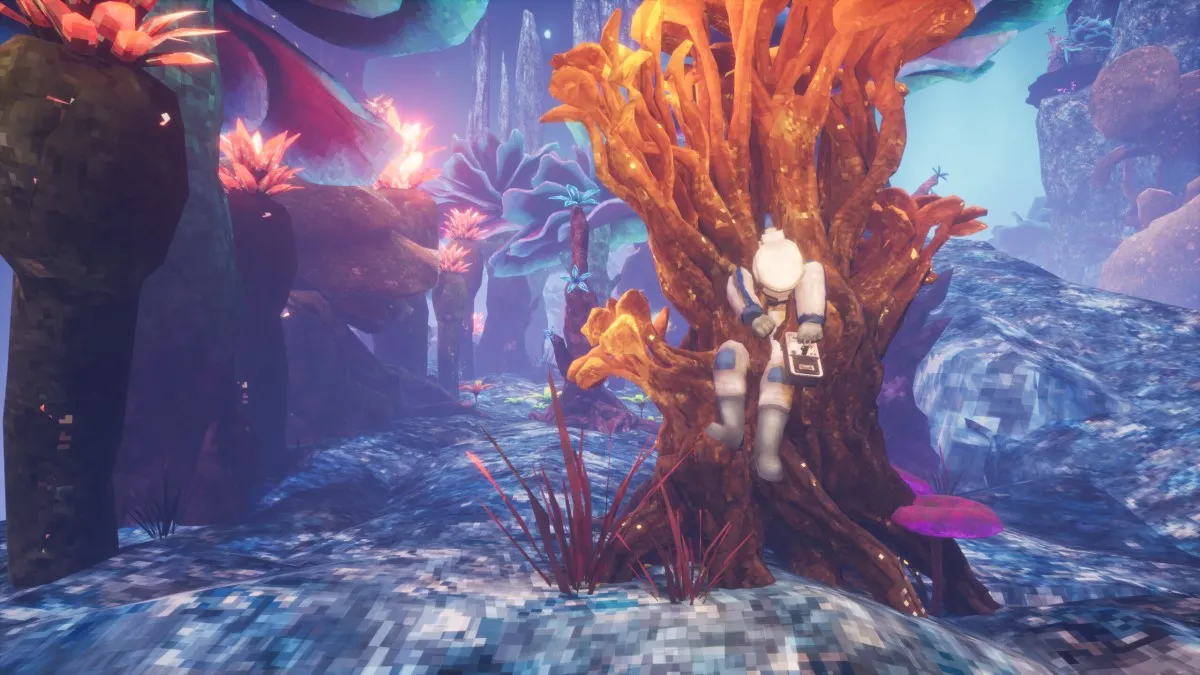Approaching the speed of light, but never surpassing it
Since Braid hit it big in 2008, puzzle platformers have been indie bread and butter. Manipulation of physics concepts like time and gravity has become relatively common in the genre. Constant C takes those ideas a half step further, by combining them.
In the end, it works. Though gravity control is nothing new, the combination of it with the frozen time mechanic allows for situations that have not been seen before. Some of these situations come up more often than they need to, but the journey stays interesting enough to see it through to the end in Constant C.

Constant C (PC [reviewed], Xbox 360)
Developer: International Games System
Publisher: International Games System
Released: March 11, 2014
MSRP: $9.99
Rig: AMD Phenom II X2 555 @ 3.2 GHz, with 4GB of RAM, ATI Radeon HD 5700, Windows 7 64-bit
Players take on the role of the Rescue Robot, which finds itself on a space station where time stands still. The robot protagonist has a short range field around it that allows time to flow, affecting everything within the bubble. With this ability, it must determine what happened to the space station, and what can be done to fix it.
Not long into the investigation, it meets the space station’s artificial intelligence, which bestows on the Rescue Robot a second piece of technology, allowing it to alter gravity to pull in any of the four cardinal directions.
Though that may make it sound like the player has limitless power, the real obstacle through most of the game is the Rescue Robot’s fragility. If it falls more than a few meters onto flat ground, it will explode. If it finds itself underneath a crate, it will be crushed (and explode). If it touches one of the space station’s many lasers or circular saws, it will be sliced in half (and explode). Throughout the game, the Rescue Robot does quite a bit of exploding.
On top of that, the gravity manipulation has a bit of a cooldown, preventing the player from using it to move short distances safely. When the room flips, the Rescue Robot had better have a safe flight path for about a second before he can alter gravity again.
The Rescue Robot’s time bubble takes a bit of getting used to as well. The key characteristic of it is that it is completely passive, and it cannot be turned off. There are puzzle rooms in which the player would benefit from a complete stoppage of time, so he could stand on top of an unsupported crate, or pass through an area without disturbing a laser, but he must always be mindful of the circle surrounding him.

Some interesting solutions arise from the Rescue Robot’s powers, but a few solutions come up several times, highlighting the fact that Constant C has more levels than puzzles. For instance, several rooms are solved by riding a crate as it falls, jumping off, flipping gravity 180 degrees, and then riding it up as it continues its projectile motion. It is fun and clever the first time, but routine by the third or fourth iteration.
That said, the game would have been long enough even without the padding, and some of the puzzles toward the end are fairly difficult, though not insurmountable. One welcome mechanic is that most rooms have a standard solution that requires the Rescue Robot to get to the exit, and an additional bonus objective that requires more difficult platforming and/or puzzle solving. While it is great to be able to move forward past an unsolved puzzle, the result is a bit strange in that some rooms have trivial standard solutions and the only real puzzle to solve is in getting the optional objective.

It is through the optional objectives that the story behind the space station is told. As the Rescue Robot collects the data cells, the station’s AI unlocks recordings of the past, when the space station was not locked in time and still had human inhabitants. The story is serviceable enough, and it has its own twists and vague points to speculate on, but it will not amaze anyone.
Graphically, Constant C works well. Though the setting makes for necessarily drab greys, background effects like sparks that fly when the Rescue Robot is near help to make it feel less lifeless, despite being so. Otherwise, the art style is suitably minimalist, highlighting objects that can be interacted with for ideal clarity.
In the end, Constant C is a solid puzzle platformer that takes a few familiar ideas and mashes them together to create something partially new. The difficulty of the puzzles ranges from trivial to diabolical, with most falling somewhere in between. Its greatest sin is the repetition of certain puzzles, but if that is the worst aspect of Constant C, then it should still please fans of the genre.





Published: Apr 9, 2014 02:00 pm